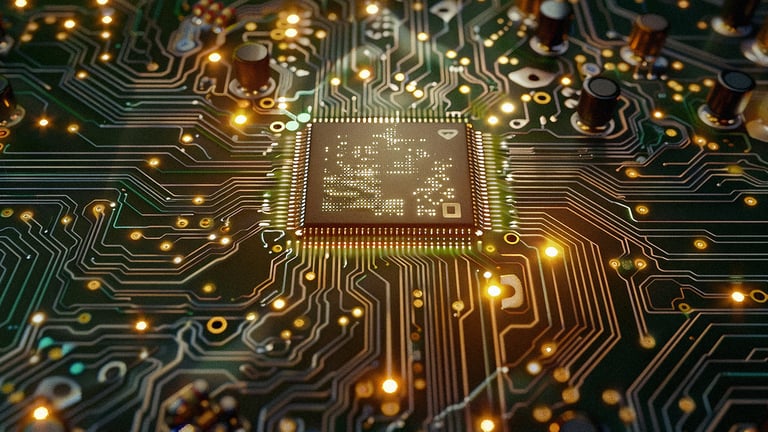As good as gold

By Cape Capital
16.04.2024

Author of The Everything Blueprint: The Microchip Design That Changed the World, James Ashton discusses the game-changing rise of semiconductors and their role in geopolitics.
Think of the world’s greatest inventions and perhaps penicillin, or electricity, or the internet springs to mind. But microchips – tiny slivers of silicon stacked with transistors that amount to a $550 billion a year industry – are an often-forgotten contender, integral to all kinds of objects from cars to computers, security systems to oil pipelines, pacemakers to nuclear missiles. Their importance in today’s technology-driven, digital-first society is extraordinary. It’s no wonder then, that former managing director of Samsung Electronics Yun Jong-yong has labelled them as ‘industrial rice’. Or that in 2021, President Biden called the shortage of computer chips caused by a pandemic induced combination of increased demand and reduced production ‘a 21st-century horseshoe nail’.

It’s a subject that James Ashton, financial journalist turned consultant and author of The Everything Blueprint: The Microchip Design That Changed the World, knows plenty about. ‘The microchip is an expression of what humans can do when we put our mind to it; it’s something quite astonishing,’ he says, describing it in his book as ‘the ultimate prize’ in geopolitics. ‘Their supply and the secrets required to make them efficiently are worth more than the world’s stock of gold or oil,’ he writes. Trace the rise of microchips (also known as semiconductors, integrated circuits and microprocessors) back to their 1950s American roots and what’s immediately clear is that making them is a global endeavour only made possible by a handful of specialist key players.
Of these, perhaps one of the most unlikely is Arm (Advanced RISC Machines), a company that began life in Cambridge in 1990, and whose narrative is at the heart of James’ book. ‘It’s the biggest British corporate story that I thought deserved telling,’ he explains, of what sparked his initial interest in the topic. ‘Arm doesn’t make anything: what it has is instruction set architecture (ISA), essentially a rulebook for how software can control hardware. There are only several thousand instructions but they can be configured into around four billion possible encodings.’ Developers buy a licence from Arm and can either use its designs off-the-shelf or alter them as they wish.
‘Arm’s designs meant that chips could be low-cost and power-efficient – those are the two factors that have worked for the company from the beginning. It’s why Amazon uses Arm ISA for is own Graviton chip and why Arm architecture was perfect for Apple’s fantastic period of innovation, starting with the iPod in 2001,’ continues James, of the ‘Switzerland of semiconductors’ that does business with rivals Apple, Samsung and Google simultaneously. ‘Every time an Arm design is used in a device – and sometimes there are many designs per device – a royalty is paid. I can’t think of a more prevalent, more frequently used British export.’
Other instrumental companies include Europe’s most valuable technology firm, Dutch ASML, which produces extreme ultraviolet lithography machines at the cost of €160m each (‘it took decades to develop the technology which project the chip design onto silicon,’ says James), and the Taiwan Semiconductor Manufacturing Company (TSMC). Until now, the latter, which supplies the likes of Intel, has been regarded as a ‘silicon shield’ that protects Taiwan from Chinese attack while maintaining US backing. ‘Both China and the US are very reliant on TSMC,’ confirms James. ‘It’s why there’s huge investment in all regions, including China whose ambition to be self-sufficient goes back to 2014. It’s clear to politicians that microchips are something you don’t want to be without.’
The issue, James explains, is the intricate global supply chain – ‘chips arrive in China, perhaps from Taiwan, which are installed into white goods that are then sent to the US’ – which has been affected by five years of American trade restrictions to China. ‘The US keeps tightening controls so more companies are captured in the narrative of who can sell what to enter China; it’s not just US-made goods but goods using US origin technology.’
If there is any doubt as to how critical microchips are in modern geopolitics, just look at the recent surge in investing in the race for ‘silicon sovereignty’. James cites the European Commission’s 2021 European Chips Act, which set a target that by 2030 the European Union should account for at least a fifth of the world market by value for cutting-edge and sustainable semiconductors; South Korea’s Samsung-led decade-long $451bn programme; and America’s Frontier Fund, which launched in 2022 to steer funds into critical technologies, as examples.

This financing looks set to become even more necessary as the inevitable need for microchips increases. ‘Look, for instance, at the car industry. As cars go from combustion engine to electric, they are becoming computers on wheels, a kind of library of apps like the smartphone has become,’ says James. ‘Then there’s AI and the growth of data centres, which are effectively huge computing farms.’ For AI, specific types of chips are needed, such as a GPU chip, which started out as a graphics processor for computer games. ‘A GPU chip is in your games console or computer, there to make the graphics look smart. The brilliance of it is that rather than executing commands one after the other, it can do many things at once.’
Ideas to enhance microchip capabilities in the future, include biocomputing and photonic processing, which offers the promise of accelerating calculation speeds and lowering power demands by replacing electrical transistors with optical light pulses. ‘At this point we’re bumping up against the laws of physics. There's a question about how much denser things can be and about what materials to use; it might be time to retire silicon and look at what we can do with gallium compounds or germanium,’ he concludes. ‘There’s no doubt, microchips are the global race writ large.’